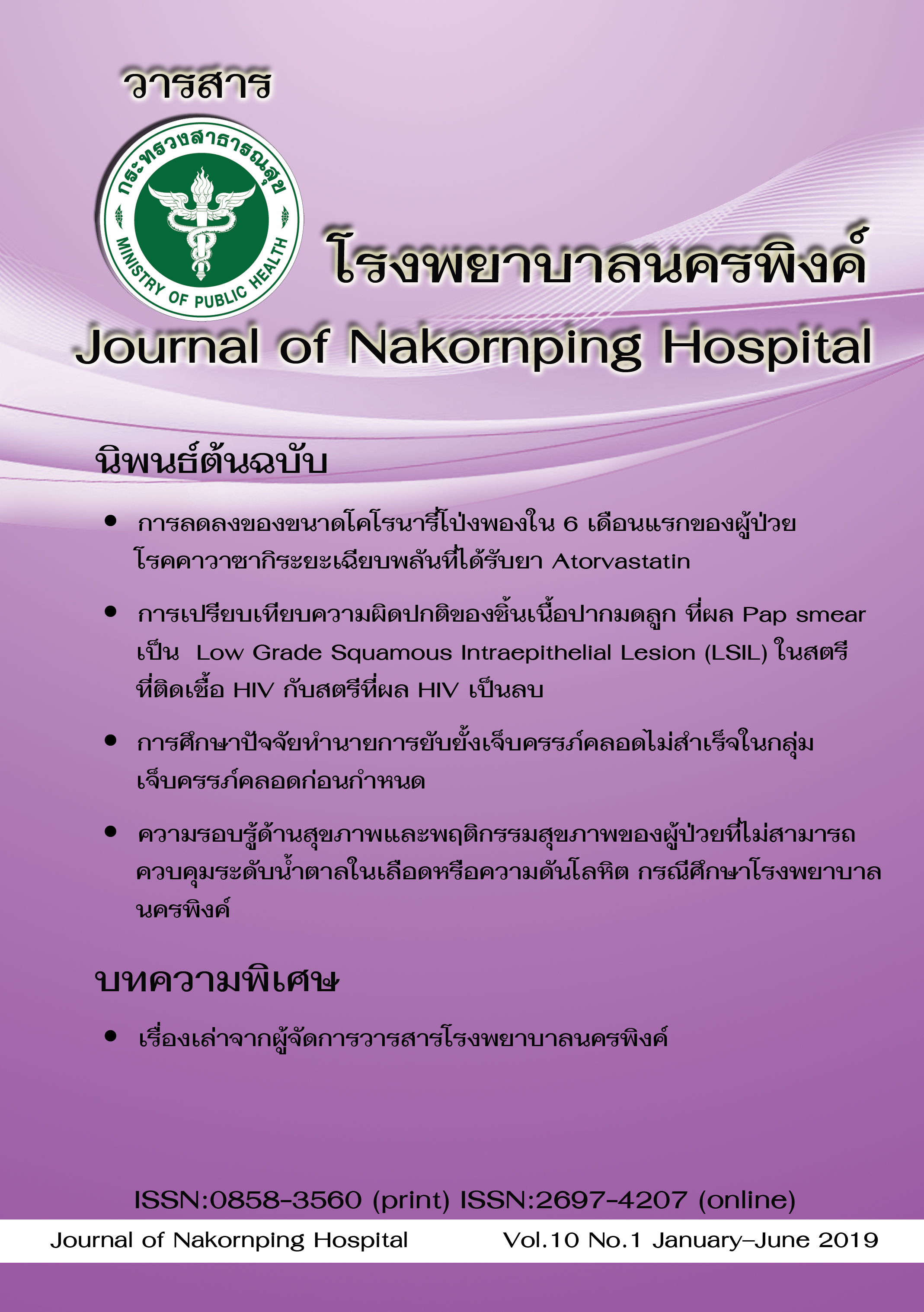Predicting factors associated with preterm birth after receiving stopping preterm labor treatment
Keywords:
stopping preterm labor, preterm labor, preterm birthAbstract
Nowadays preterm birth is a major problem of Ministry Public Health that resulting in neonatal complications. This study aimed to find associated factors about preterm birth after stopping preterm labor in Nakornping hospital. The study was conducted by retrospective cohort study method. Four hundred and sixty eligible cases were enrolled from January 1th2016 to December 31st 2018 and assigned to be a study group, singleton pregnant women who were stopped preterm labor then failed to continue pregnancy, and comparison group, singleton pregnant women who were stopped preterm labor and success of continuing pregnancy to term pregnancy. Data was analyzed by using univariable and multivariable binary regression and presented in Relative risk (RR), 95% confidence interval (CI) and p-value less than 0.05 is used as the cutoff for the significance.
After stopping preterm labor, 212 of 460 eligible pregnant women had given preterm birth, the prevalence of preterm birth was 41.6%, this study group had mean age(SD) was 27.08(6.60) years, gestational age at the first experience of labor pain was 32.15(2.75) weeks and body mass index before getting pregnant was 22.83(3.67) kg/m2. This study found that the independent factors that associated with preterm birth were gestational age at the first experience of labor pain (RR 1.51, 95% CI 1.20-1.89) and premature ruptured of membrane (RR 1.91, 95%CI 1.60-2.28). In summary, under the standard guideline to stop preterm labor, our study had shown that gestational age at the first experience of labor pain and premature ruptured of membrane were strongly related to preterm birth.
References
2. Murphy DJ. Epidemiology and environmental factors in preterm labour. Best Practice & Research Clinical Obstetrics & Gynaecology. 2007;21(5):773-89.
3. Cunningham FG, Bloom S, Spong CY, Dashe JS. et al. Willams Obstretics. 24th ed, New York:McGraw-Hill Education; 2014.
4. Su D, Samson K, Garg A, Hanson C, Anderson Berry AL, Lin G, et al. Birth history as a predictor of adverse birth outcomes: Evidence from state vital statistics data. Preventive Medicine Reports. 2018;11:63-8.
5. McClure EM, Goldenberg RL. Use of antibiotics to reduce preterm birth. The Lancet Global Health. 2019;7(1):e18-e9.
6. Norman JE, Marlow N, Messow C-M, Shennan A, Bennett PR, Thornton S, et al. Vaginal progesterone prophylaxis for preterm birth (the OPPTIMUM study): a multicentre, randomised, double-blind trial. The Lancet. 2016;387(10033):2106-16.
7. Simcox R, Shennan A. Cervical cerclage: A review. International Journal of Surgery. 2007;5(3):205-9.
8. Appiah-Sakyi K, Konje JC. Prevention of preterm labour. Obstetrics, Gynaecology & Reproductive Medicine. 2015;25(9):255-60.
9. Morisaki N, Nagata C, Jwa SC, Sago H, Saito S, Oken E, et al. Pre-pregnancy BMI-specific optimal gestational weight gain for women in Japan. Journal of Epidemiology. 2017;27(10):492-8.
10. Newnham JP, White SW, Meharry S, Lee H-S, Pedretti MK, Arrese CA, et al. Reducing preterm birth by a statewide multifaceted program: an implementation study. American Journal of Obstetrics and Gynecology. 2017;216(5):434-42.
11. Ioakeimidis N, Vlachopoulos C, Katsi V, Tousoulis D [Internet]. Smoking cessation strategies in pregnancy: Current concepts and controversies. Hellenic Journal of Cardiology; 2018 [updated 2018 Oct 5; cited 26 May 2019 ] Available from doi.org/10.1016/j.hjc.2018.09.001
12. You S-H, Chang Y-L, Yen C-F. Rupture of the scarred and unscarred gravid uterus: Outcomes and risk factors analysis. Taiwanese Journal of Obstetrics and Gynecology. 2018;57(2):248-54.
13. Shin JE, Shin JC, Kim SJ, Lee Y, Park IY, Lee S. Early midtrimester serum insulin-like factors and cervical length to predict preterm delivery. Taiwanese Journal of Obstetrics and Gynecology. 2016;55(1):45-9.
14. Xiang L-J, Wang Y, Lu G-Y, Huang Q. Association of the presence of microangiopathy with adverse pregnancy outcome in type 1 diabetes: A meta-analysis. Taiwanese Journal of Obstetrics and Gynecology. 2018;57(5):659-64.
15. Hosny AE-DMS, El-khayat W, Kashef MT, Fakhry MN. Association between preterm labor and genitourinary tract infections caused by Trichomonas vaginalis, Mycoplasma hominis, Gram-negative bacilli, and coryneforms. Journal of the Chinese Medical Association. 2017;80(9):575-81.
16. Tellapragada C, Eshwara VK, Bhat P, Kamath A, Aletty S, Mukhopadhyay C. Screening of vulvovaginal infections during pregnancy in resource constrained settings: Implications on preterm delivery. Journal of Infection and Public Health. 2017;10(4):431-7.
17. Chen K-J, Chang Y-L, Chang H, Su S-Y, Peng H-H, Chang S-D, et al. Long-term outcome of pregnancy complicating with severe aplastic anemia under supportive care. Taiwanese Journal of Obstetrics and Gynecology. 2017;56(5):632-5.
18. Li Y, Wei Q-f, Meng D-h, Pan X-n, Mo Y, Yao L-p, et al. Treatment outcomes and associated factors among extremely preterm infants in a major children hospital in Guangxi, China. Pediatrics & Neonatology. 2018;59(3):263-6.
19. Chandra I, Sun L. Third trimester preterm and term premature rupture of membranes: Is there any difference in maternal characteristics and pregnancy outcomes?. Journal of the Chinese Medical Association. 2017;80(10):657-61.
20. Lu L, Qu Y, Tang J, Chen D, Mu D. Risk factors associated with late preterm births in the underdeveloped region of China: A cohort study and systematic review. Taiwanese Journal of Obstetrics and Gynecology. 2015;54(6):647-53.
21. Boelig RC, Orzechowski KM, Berghella V. Cervical length, risk factors, and delivery outcomes among women with spontaneous preterm birth. The Journal of Maternal-Fetal & Neonatal Medicine. 2016;29(17):2840-4.
22. Youssef A, Al-Eissa HSBA. Risk factors for spontaneous preterm birth in a Saudi population. European Journal of Obstetrics & Gynecology and Reproductive Biology. 1994;57:19-24
Downloads
Published
How to Cite
Issue
Section
License
The articles that had been published in the journal is copyright of Journal of Nakornping hospital, Chiang Mai.
Contents and comments in the articles in Journal of Nakornping hospital are at owner’s responsibilities that editor team may not totally agree with.



